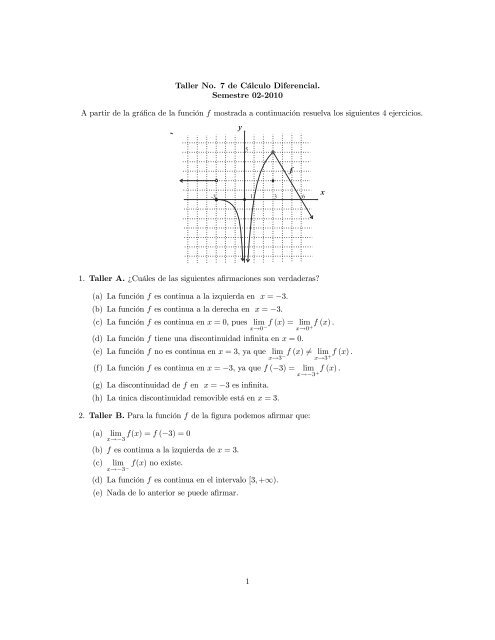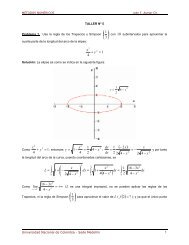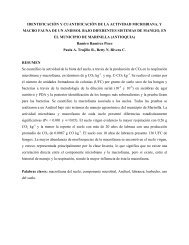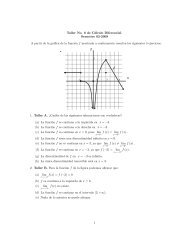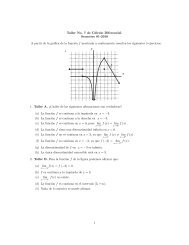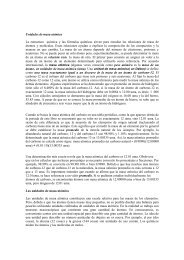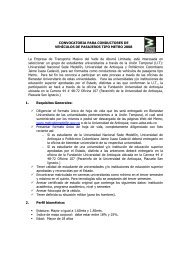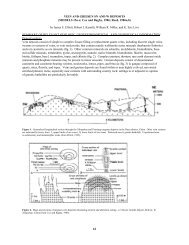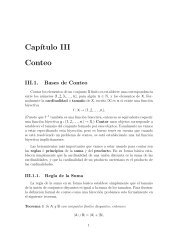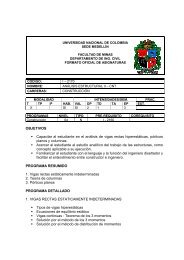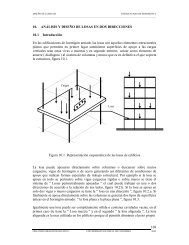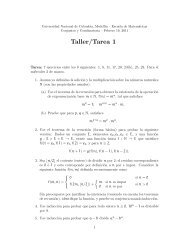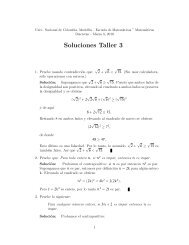Taller No. 7 de Cálculo Diferencial. Semestre 02-2010 A partir de la ...
Taller No. 7 de Cálculo Diferencial. Semestre 02-2010 A partir de la ...
Taller No. 7 de Cálculo Diferencial. Semestre 02-2010 A partir de la ...
You also want an ePaper? Increase the reach of your titles
YUMPU automatically turns print PDFs into web optimized ePapers that Google loves.
<strong>Taller</strong> <strong>No</strong>. 7 <strong>de</strong> <strong>Cálculo</strong> <strong>Diferencial</strong>.<br />
<strong>Semestre</strong> <strong>02</strong>-<strong>2010</strong><br />
A <strong>partir</strong> <strong>de</strong> <strong>la</strong> gráfica <strong>de</strong> <strong>la</strong> función f mostrada a continuación resuelva los siguientes 4 ejercicios.<br />
1. <strong>Taller</strong> A. ¿Cuáles <strong>de</strong> <strong>la</strong>s siguientes afirmaciones son verda<strong>de</strong>ras?<br />
(a) La función f es continua a <strong>la</strong> izquierda en x = −3.<br />
(b) La función f es continua a <strong>la</strong> <strong>de</strong>recha en x = −3.<br />
(c) La función f es continua en x = 0, pues lim<br />
x→0−f (x) = lim<br />
x→0 +f<br />
(x) .<br />
(d) La función f tiene una discontinuidad infinita en x = 0.<br />
(e) La función f no es continua en x = 3, ya que lim<br />
x→3−f (x) = lim<br />
x→3 +f<br />
(x) .<br />
(f) La función f es continua en x = −3, ya que f (−3) = lim<br />
x→−3 +f<br />
(x) .<br />
(g) La discontinuidad <strong>de</strong> f en x = −3 es infinita.<br />
(h) La única discontinuidad removible está en x = 3.<br />
2. <strong>Taller</strong> B. Para <strong>la</strong> función f <strong>de</strong> <strong>la</strong> figura po<strong>de</strong>mos afirmar que:<br />
(a) lim f(x) = f (−3) = 0<br />
x→−3<br />
(b) f es continua a <strong>la</strong> izquierda <strong>de</strong> x = 3.<br />
(c) lim<br />
x→−3− f(x) no existe.<br />
(d) La función f es continua en el intervalo [3, +∞).<br />
(e) Nada <strong>de</strong> lo anterior se pue<strong>de</strong> afirmar.<br />
1
3. <strong>Taller</strong> A. Con respecto a <strong>la</strong> función f <strong>de</strong> <strong>la</strong> gráfica, ¿cuál <strong>de</strong> los siguientes enunciados es verda<strong>de</strong>ro?<br />
(a) f es continua en el intervalo (∞, −3].<br />
(b) f es continua en el intervalo [−3, 0]<br />
(c) f es continua en el intervalo [1, 6]<br />
(d) f es continua en el intervalo [−3, 0).<br />
4. <strong>Taller</strong> B. Sean g <strong>la</strong> función <strong>de</strong>finida por g (x) = x + 2 y f <strong>la</strong> función <strong>de</strong> <strong>la</strong> gráfica. ¿Cuáles <strong>de</strong><br />
<strong>la</strong>s siguientes afirmaciones son falsas?<br />
(a) f ◦ g es discontinua en x = 0.<br />
(b) g ◦ f es discontinua en x = 0.<br />
(c) f ◦ g es discontinua en x = 3.<br />
(d) g ◦ f es discontinua en x = 3.<br />
(e) g ◦ f es continua a <strong>la</strong> <strong>de</strong>recha <strong>de</strong> x = −3.<br />
(f) f ◦ g es continua a <strong>la</strong> <strong>de</strong>recha <strong>de</strong> x = −3.<br />
(g) f ◦ g es continua en x = 6.<br />
(h) g ◦ f es continua en x = 6.<br />
5. <strong>Taller</strong> A. Si f es una función continua en [−1, 1] . ¿Cuál <strong>de</strong> <strong>la</strong>s siguientes afirmaciones podría<br />
ser falsa?<br />
(a) Si lim f (x) existe, entonces es igual a f (−1) .<br />
x→−1 +<br />
(b) Si lim f (x) existe, entonces es igual a f (1) .<br />
x→1− (c) Si lim<br />
x→−1− f (x) existe, entonces es igual a f (−1) .<br />
(d) lim<br />
x→0 f (x) = f (0)<br />
6. <strong>Taller</strong> B. Explique por qué <strong>la</strong> función f dada a continuación es discontinua en el punto x = 2.<br />
⎧<br />
⎪⎨<br />
f (x) =<br />
⎪⎩<br />
x2 + x − 6<br />
x − 2<br />
7<br />
si<br />
si<br />
x = 2<br />
x = 2<br />
⎧<br />
⎨ x + 4 si x ≤ −1<br />
7. <strong>Taller</strong> A. Sea f (x) = mx + b<br />
⎩<br />
x − 4<br />
si<br />
si<br />
−1 < x ≤ 1<br />
x > 1<br />
.<br />
Encuentre los valores <strong>de</strong> m y b, para que <strong>la</strong> función f sea continua en todos los reales.<br />
(a) Haga el procedimiento en forma analítica, buscando ecuaciones al utilizar <strong>la</strong> <strong>de</strong>finición <strong>de</strong><br />
continuidad y <strong>de</strong>terminando con estas ecuaciones los valores <strong>de</strong> m y b.<br />
(b) Haga el procedimiento <strong>de</strong> <strong>la</strong> siguiente forma: dibuje <strong>la</strong> gráfica <strong>de</strong> <strong>la</strong> función en los intervalos<br />
(−∞, −1] y en [1, ∞) y luego busque <strong>la</strong> ecuación <strong>de</strong> <strong>la</strong> recta que empata bien con los dos<br />
tramos dibujados. Compare su respuesta con <strong>la</strong> respuesta encontrada analíticamente.<br />
2
8. <strong>Taller</strong> B. Sea g <strong>la</strong> función cuya gráfica se muestra a continuación.<br />
Para <strong>la</strong> función g, complete <strong>la</strong> siguiente información.<br />
lim g (x) = _____, lim<br />
x→∞ x→−∞<br />
lim<br />
x→−4<br />
x→1<br />
g (x) = _____, lim g (x) = _____,<br />
x→−4− x→1<br />
g (x) = _____, lim g (x) = _____, lim g (x) = _____,<br />
+ − +<br />
lim<br />
x→−2 +<br />
g (x) = _____, lim<br />
x→−2− g (x) = _____, lim g (x) = _____,<br />
x→0<br />
g (−4) = _____, g (−2) = _____, g (1) = _____,<br />
(a) El dominio <strong>de</strong> g es:________<br />
(b) La(s) ecuación(es) <strong>de</strong> <strong>la</strong>(s) asíntota(s) vértical(es) es(son):________<br />
(c) La(s) ecuación(es) <strong>de</strong> <strong>la</strong>(s) asíntota(s) horizontal(es) es(son):________<br />
(d) La función g tiene discontinuidad removible (evitable) en los siguientes valores <strong>de</strong> x:________<br />
(e) La función g tiene discontinuidad esencial finita o infinita (no evitable, no removible o por<br />
salto) en los siguientes valores <strong>de</strong> x:________<br />
9. <strong>Taller</strong> A. Para <strong>la</strong> función g <strong>de</strong>l problema anterior indique si es verda<strong>de</strong>ro (V) o falso (F) cada<br />
uno <strong>de</strong> los siguientes enunciados.<br />
(a) g es continua en x = 1._____<br />
(b) g es continua en x = 0._____<br />
(c) La discontinuidad a <strong>la</strong> izquierda <strong>de</strong> x = 1 es removible._____<br />
(d) La discontinuidad a <strong>la</strong> <strong>de</strong>recha <strong>de</strong> x = −2 es removible._____<br />
(e) g tiene una discontinuidad por salto en x = −2._____<br />
(f) g tiene una discontinuidad por salto en x = −4._____<br />
(g) g tiene una discontinuidad infinita a <strong>la</strong> <strong>de</strong>recha <strong>de</strong> x = −4._____<br />
(h) La discontinuidad a <strong>la</strong> izquierda en x = −4 es removible._____<br />
(i) Po<strong>de</strong>mos afirmar que g tiene una asíntota vértical en x = −4, porque g tiene discontinuidad<br />
esencial (no removible) en x = −4._____<br />
(j) g tiene una asíntota vértical en x = −4 ya que lim g (x) = −∞._____<br />
x→−4 +<br />
3
10. <strong>Taller</strong> B. Para <strong>la</strong> ecuación ln x = 2x − 3 se pue<strong>de</strong> afirmar que:<br />
(a) Tiene una raíz en el intervalo (0, e).<br />
(b) Tiene una raíz en el intervalo (1, e).<br />
(c) Tiene una raíz en el intervalo (1, 3<br />
2 ).<br />
(d) <strong>No</strong> tiene soluciones.<br />
11. <strong>Taller</strong> A. Si g (t) = 3t3 − t + 1, <strong>de</strong>muestre que existe un número c en el intervalo (−1, 1) tal que<br />
g (c) = 0.<br />
<br />
2 cos(π/x) x e si x = 0<br />
12. <strong>Taller</strong> B. Si f (x) =<br />
entonces po<strong>de</strong>mos afirmar que:<br />
0 si x = 0<br />
(a) lim<br />
x→0 x 2 e cos(π/x) no existe.<br />
(b) f es continua en x = 0.<br />
(c) f es discontinua en x = 0.<br />
(d) lim<br />
x→0 x 2 e cos(π/x) no se pue<strong>de</strong> calcu<strong>la</strong>r.<br />
13. <strong>Taller</strong> A. Si f es continua en todos los reales y f(5) = 2, f(4) = 4 y lim g(x) = 5 . El valor <strong>de</strong><br />
x→4<br />
lim f(g(x)) es:<br />
x→4<br />
(a) 4 (b) 10 (c) 2 (d) <strong>No</strong> se pue<strong>de</strong> calcu<strong>la</strong>r<br />
14. Calcu<strong>la</strong>r si existen los siguientes límites (<strong>Taller</strong> B. literales (a);(c);(e);(g) e (i). El resto <strong>de</strong><br />
literales en <strong>Taller</strong> A):<br />
(a) lim<br />
x→3 +<br />
ln x2 − 9 <br />
(d) lim<br />
(g) lim<br />
x→−∞<br />
(b) lim<br />
x→( π<br />
x→−∞ x4 + x5 (e) lim<br />
x→2<br />
√<br />
x2 + x + x (h) lim<br />
x→∞<br />
etan x (c) lim tan<br />
x→2 −1<br />
2 )+<br />
<br />
cos tan−1 2 x − 4<br />
3x2 <br />
− 6x<br />
2<br />
√<br />
x2 + x − x<br />
15. <strong>Taller</strong> A. Sea f una función tal que para todo x > 1,<br />
lim f (x).<br />
x→∞<br />
16. <strong>Taller</strong> B. Encuentre <strong>la</strong>s asíntotas verticales y horizontales <strong>de</strong><br />
y = 2ex<br />
e x − 5<br />
2 x − 4<br />
3x2 <br />
− 6x<br />
4x − 3<br />
(f) lim √<br />
x→−∞ x2 + 1<br />
(i) lim<br />
x→∞<br />
√ x 2 − x 3<br />
5 √ x<br />
√ < f(x) <<br />
x − 1 10ex − 21<br />
2ex . Encuentre<br />
17. <strong>Taller</strong> A. Dibuje <strong>la</strong> gráfica <strong>de</strong> una función f que satisfaga <strong>la</strong>s condiciones dadas:<br />
(a) f (1) = 2, lim<br />
x→1<br />
x→3<br />
x→3<br />
f(x) = −∞, f(3) = 1, lim f(x) = 1, lim f(x) = ∞,<br />
+ − +<br />
lim<br />
x→∞ f(x) = −2, Df = R, f (−x) = −f (x)<br />
4
18. <strong>Taller</strong> B. Para <strong>la</strong> función g, <strong>de</strong>rivable en los reales y cuya gráfica se da a continuación, disponga<br />
los números siguientes en or<strong>de</strong>n creciente y explique su razonamiento:<br />
0; g ′ (−6); g ′ (−5); g ′ (−3); g ′ (−1); g ′ (0); g ′ (1); g ′ (3); g ′ (5).<br />
19. <strong>Taller</strong> A. Trace <strong>la</strong> gráfica <strong>de</strong> una función g para <strong>la</strong> cual<br />
g(1) = g ′ (1) = 0, g ′ (−2) = −1, g ′ (2) = 2, g ′ (5) = 1<br />
20. <strong>Taller</strong> B. Una partícu<strong>la</strong> se mueve en línea recta con función <strong>de</strong> posición dada por s (t) = 3t 2 −t+1.<br />
Halle <strong>la</strong> velocidad instantánea v <strong>de</strong> <strong>la</strong> partícu<strong>la</strong> <strong>de</strong>spués <strong>de</strong> t segundos. ¿Cuál es el valor <strong>de</strong> v (3)?<br />
(Use <strong>la</strong> <strong>de</strong>finición <strong>de</strong> <strong>de</strong>rivada.).<br />
21. Usando <strong>la</strong> <strong>de</strong>finición <strong>de</strong> <strong>de</strong>rivada, halle f ′ (x) para cada una <strong>de</strong> <strong>la</strong>s siguientes funciones. A<strong>de</strong>más<br />
halle si es posible <strong>la</strong> ecuación <strong>de</strong> <strong>la</strong> recta tangente a <strong>la</strong> gráfica <strong>de</strong> f en el punto indicado. Dibuje<br />
<strong>la</strong> gráfica <strong>de</strong> cada una <strong>de</strong> <strong>la</strong>s funciones y observe qué ocurre.<br />
(a) <strong>Taller</strong> A. g(x) = x2 , (1, g(1)), h(x) = 2x − 1, (1, h(1)).<br />
<br />
2 x si x < 1<br />
(b) <strong>Taller</strong> A. f (x) =<br />
, (1, f (1))<br />
2x − 1 si x ≥ 1<br />
(c) <strong>Taller</strong> B. h(x) = 5 − x, (6, h(6)); f (x) = |5 − x|, (6, 1)<br />
Observación: La i<strong>de</strong>a en éste punto es <strong>de</strong>terminar <strong>la</strong> diferenciabilidad en el punto indicado<br />
para cada función y ver gráficamente lo que ocurre. <strong>No</strong>te que para algunas <strong>de</strong> <strong>la</strong>s funciones<br />
es imprescindible calcu<strong>la</strong>r <strong>la</strong> <strong>de</strong>rivada usando <strong>la</strong> <strong>de</strong>finición <strong>de</strong> <strong>de</strong>rivadas <strong>la</strong>terales.<br />
22. <strong>Taller</strong> A. El consumo <strong>de</strong> combustible (medido en galones por hora) <strong>de</strong> un automóvil que viaja<br />
a una velocidad <strong>de</strong> v mil<strong>la</strong>s por hora es c = f(v).<br />
(a) ¿Cuál es el significado <strong>de</strong> <strong>la</strong> <strong>de</strong>rivada f ′ (v)?, ¿Cuáles son sus unida<strong>de</strong>s?<br />
(b) Escriba una frase que explique el significado <strong>de</strong> f ′ (20) = −0.05.<br />
5


